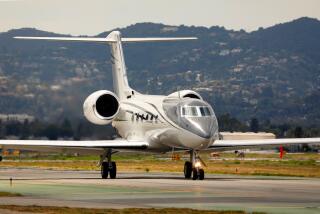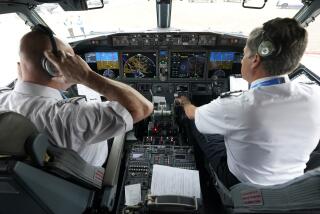Private Pilots--Clout in Capitol : Group a Major Influence on U.S. Aviation Policy
WASHINGTON — John L. Baker was watching a Sunday afternoon tennis match on television when the announcer interrupted with a news bulletin: A private plane and a Mexican airliner had collided over Southern California.
His first thought, Baker recalled, was one of concern over the potential loss of life. His second, he said, was “Oh no, here we go again. No matter the circumstances, there will be more bashing of general aviation by the press and the politicians.”
Leading Spokesman
Baker, as president of the Aircraft Owners and Pilots Assn., is the leading spokesman for America’s private pilots. And within hours of the Aug. 31 collision above Cerritos, he was heading a multifaceted effort to prevent the California tragedy from translating into what he considers unfair restrictions on private pilots.
If history is a guide, Baker and the aircraft owners association stand a good chance of succeeding. The organization, with 260,000 members and an annual budget of $24 million, has emerged as a powerful force in determining the nation’s aviation policy.
It was chiefly responsible, for instance, for diluting the Federal Aviation Administration’s proposal to place new requirements on private pilots at 44 of the nation’s busiest airports after a midair collision between a single-engine training plane and a jetliner over San Diego in 1978.
Now, in the wake of the Cerritos collision, the aircraft owners association is determined to use its political muscle to thwart what Baker foresees as efforts to limit where private pilots can fly. “We don’t fight paying the price of admission to certain airspace,” he said, “but we are against any attempt to arbitrarily exclude us.”
The Aircraft Owners and Pilots Assn.’s muscle is not only large, it is sophisticated. The best example is its “VIP list.”
Association members are encouraged to tell the organization’s headquarters which senators, U.S. representatives, governors, state legislators and other federal, state and local governmental officials they know on a first-name basis. After the information is loaded into computers, association staffers can determine at a touch of a few buttons who among the members can pick up a telephone and have a good chance of delivering the organization’s message to the appropriate officials.
For instance, Baker said, when former Sen. Birch Bayh (D-Ind.), chairman of the Senate aviation subcommittee, took a position opposite the association’s on pending legislation, the pilots’ group checked its VIP list. “We had 112 people who knew him on a first-name basis contact him within the next two days,” Baker said. “It was very effective.”
The persuasion of Bayh occurred several years ago, and Baker would cite no more recent examples. But congressional staffers attest to the association’s current clout.
‘They Have Access’
“These are people my boss pays attention to--doctors, lawyers, professional people,” one congressional aide said. “They have contributed to his campaign. They have flown him around the district. They have access.”
Besides the precision approach to lobbying, the aircraft owners association can generate massive letter-writing campaigns almost at will.
After the San Diego accident, for example, the FAA office handling public comment on the proposed new requirements for private pilots was buried under 44,000 letters, mostly from association members opposing the rules. “Of course this has an impact on us,” one FAA official said in discussing why the agency eventually modified the rule to include only two of the originally proposed 44 airports.
Those two airports--San Diego and Honolulu--joined a list of busy airports (currently 23) known as terminal control areas where all pilots operating in certain airspace are required to meet certain qualifications or have equipment that makes it possible for air traffic controllers to track aircraft on radar screens.
The aircraft owners association cranked up another big letter-writing campaign when it sought to quiet calls in Congress for FAA action after the San Diego collision. Members of the association were credited with flooding Capitol Hill with 55,000 letters--nearly four times as many as congressional offices received during the same period on another transportation issue of much broader public interest, the 55-m.p.h. speed limit.
The Cerritos collision has yet to trigger any formal proposals to change the rules regulating where private pilots may fly. But the outspoken Baker said he expects the FAA to try to “do something even if it’s wrong. Their mentality is ‘Don’t sit there; do something. Get the public off our backs.’ ”
‘Be More Aggressive’
Baker, a former military pilot, Justice Department lawyer, congressional aide, FAA official and executive of the Air Line Pilots Assn., became president of the aircraft owners association nine years ago and immediately sought to have the organization “turn outward and be more aggressive.”
Since then, the association’s membership has increased from 160,000 to 260,000, or nearly half the estimated 550,000 active licensed pilots in the country, and its annual budget has quadrupled. It has built a gleaming new national headquarters in Frederick, Md., at an airport with no restrictions on private pilots--an airport where, in fact, some of its 200 staff members practice takeoffs and landings during afternoon breaks from office duties.
The association calls itself the “voice of general aviation,” a $20-billion-a-year industry encompassing all flying except scheduled airlines and military operations. Besides pleasure flying, general aviation includes air taxis, corporate jets, charter planes and aircraft used for purposes ranging from agricultural crop spraying to aerial photography.
According to the association, pleasure flying accounts for only about 5% of the 32 million air hours logged last year by general aviation, a figure that compares with 7.8 million hours flown by commercial airlines.
With its lobbying prowess, the association has also been called the “NRA of the Air,” a reference to the National Rifle Assn. and its usually effective efforts to curb controls on gun owners.
Baker called the comparison an unfair generalization. “It is a nice, handy way to write off something far more complex,” he said. “I wish our problem were as simple as the NRA’s--they have only a single issue.”
Other Issues
Indeed, in recent years the aircraft owners association has immersed itself in issues far beyond private pilots’ access to the nation’s increasingly crowded airspace.
It has been urging, for example, that the FAA be removed from the Transportation Department and returned to its pre-1966 status as an independent agency. “The FAA can do its job better without that extra layer of bureaucracy,” Baker said.
It has gone to Congress to block a Reagan Administration proposal to eliminate 700 jobs at FAA flight service stations, which are responsible for briefing pilots on the weather and handling their flight plans.
It has tangled with the FAA over its plan to designate 130 additional locations as airport radar surveillance areas, in which pilots must be in radio contact with air traffic controllers. So far, the FAA has established only 64 such areas, in part because of private pilots’ vigorous contention that the new rules would actually increase the danger of midair collisions by overburdening controllers.
It has caused the FAA to move more slowly than some safety advocates would like in requiring that private planes be equipped with more sophisticated cockpit equipment, such as devices that make the planes easier to spot on radar screens. The association argues that the added expense for pilots would not substantially improve safety.
The Air Line Pilots Assn., which represents 39,000 commercial pilots, and the Air Transport Assn., which represents the major carriers, have urged that more controls be placed on small planes at busy airports. An Air Line Pilots Assn. spokesman cites steadily increasing reports of near-collisions as a warning that more controls are needed.
But John E. O’Brien, director of engineering and air safety for the Air Line Pilots Assn., said the small plane group seems to have more clout than the airline pilots. “There are 39,000 of us and 300,000 of them,” he said. “And they have a PAC.”
Contributed $100,000
This was a reference to the aircraft owners association’s political action committee, which, according to federal records, has contributed about $100,000 to this year’s congressional campaigns--a relatively modest amount compared with other PACs. Most of the money went to chairmen of committees handling aviation issues and to the 16 senators and 30 U.S. representatives who are pilots.
A congressional aide said the aircraft owners association’s clout comes not so much from PAC contributions as from the fact that its members tend to be outspoken, affluent and influential constituents.
The group’s fights are waged in the halls of Congress and the FAA, largely out of public view. But the association becomes more visible to the public when suggestions are made that private pilots’ access to the nation’s skies be restricted.
Within days of the Cerritos collision, Baker had made more than two dozen radio and television appearances and had flown to California for a press conference and meetings with newspaper editors. His message was invariably the same--that the California accident was an “anomaly” and that there was no reason to penalize all private pilots because of the mistake of one.
More to Read
Sign up for Essential California
The most important California stories and recommendations in your inbox every morning.
You may occasionally receive promotional content from the Los Angeles Times.










